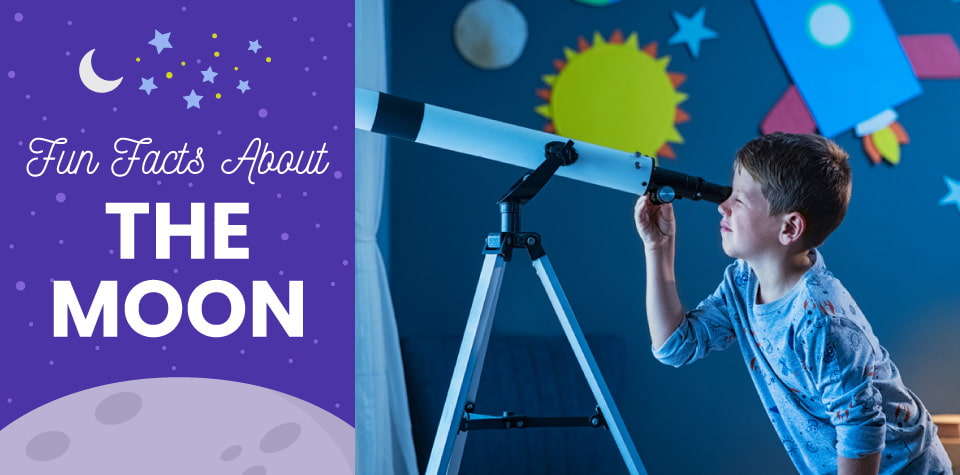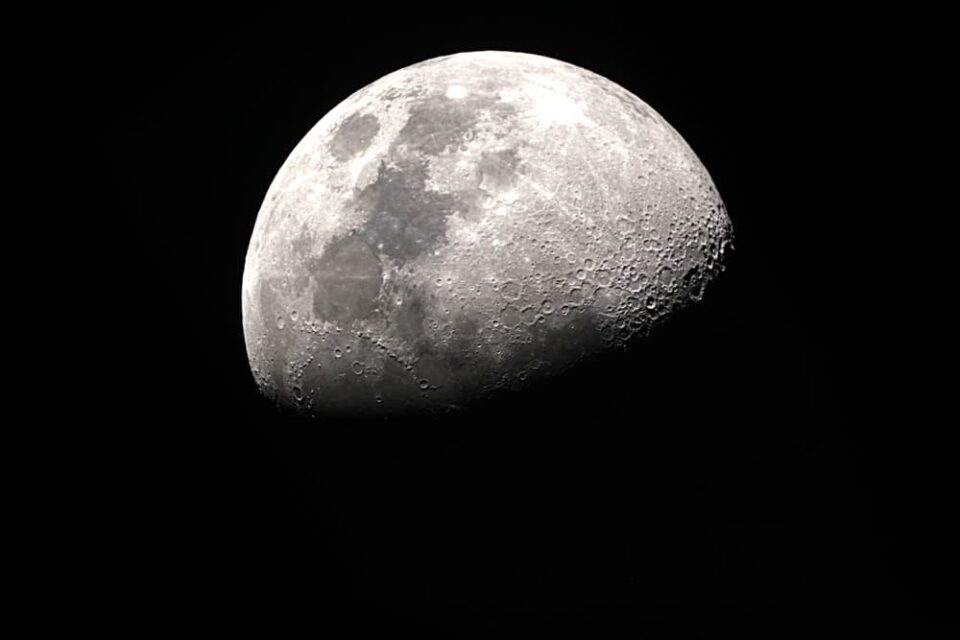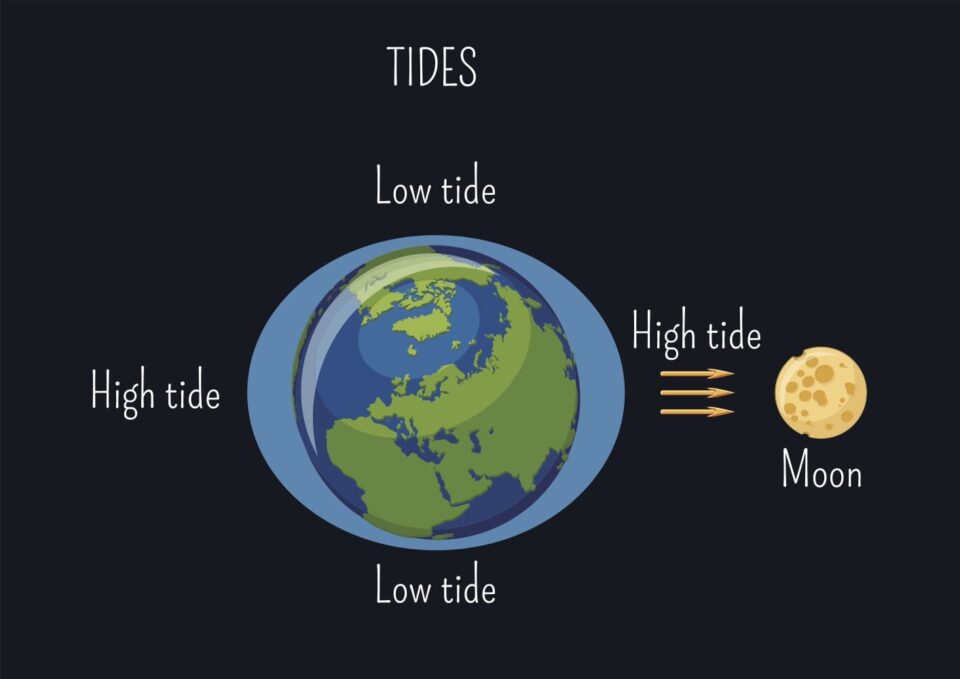
Blast Off to Discovery! Explore These Fun Facts about the Moon
Children are curious about their world … and beyond! As they grow more aware of their surroundings, one of the first things that will capture their attention is the sky and everything in it, including the Moon.
The Moon has fascinated humankind since we first looked at the night sky in wonder, and its influence on world cultures through art, science, and myth is enormous. So it’s only natural that kids have plenty of questions about Earth’s nearest celestial neighbor.
To help you prepare, we’ve gathered these fun facts about the Moon that will hopefully launch your child—and you!—on further explorations of the wonders of the solar system.
Five Interesting Facts about the Moon
Here are five essential facts about the Moon for kids that will springboard their quest to learn more.
- EARTH’S NEAREST NEIGHBOR: The Moon might seem close, but it would take three days in a spacecraft traveling at more than 3,000 miles per hour to reach it—a trip of approximately 238,855 miles.
- IT DOESN’T GLOW: While it’s one of the brightest lights in the night sky, the Moon doesn’t create its own visible light. The surface of the Moon is actually dark. The Sun’s rays reflect off the lunar surface toward Earth to produce the moonlight we see at night.
- THE CLOSEST HEAVENLY BODY: The Moon is our planet’s nearest neighbor in space and is the fifth largest natural satellite in our solar system.
- CREATED BY A ROCK THAT COLLIDED WITH EARTH: Scientists aren’t exactly sure what caused the Moon’s creation, but their best theory is that a Mars-sized rock named Theia crashed into Earth about 4.5 billion years ago. Over time, the Moon formed from the debris caused by this collision as it cooled and condensed into a solid mass.
- HUMANS WALKED ON THE MOON: Luna 1, an uncrewed rocket from the Soviet Union, launched the space race in 1959 when it successfully orbited our nearest neighbor. Since then, twelve astronauts from the USA have walked on the Moon’s surface, starting with Neil Armstrong from the Apollo 11 mission in 1969. Humans will return for our first Moon landing since 1972’s Apollo 17 mission as part of NASA’s new Artemis Program.
Facts about the Moon Phases
One of the most noticeable things about the Moon is that it looks different from night to night. These nightly changes are due to the distinct phases that collectively make up the lunar cycle. Your favorite space explorers will surely want to know more, so here’s some info to inspire them to launch an investigation of their own:
- PHASES OF THE MOON: The Moon goes through eight phases as it completes its lunar cycle: new Moon (dark), waxing crescent, first quarter, waxing gibbous, full Moon, waning gibbous, third quarter, and waning crescent. The names describe how the Moon changes from night to night. Waxing means to grow, while waning means to shrink.
- THE MOON’S ORBIT IS RESPONSIBLE FOR ITS PHASES: Just like our planet moves around the Sun, the Moon orbits Earth. This celestial round trip takes roughly 27 days, during which sunlight hits different sides of the Moon, creating the different phases seen from Earth.
- WE ALWAYS SEE THE SAME SIDE: Like Earth, the Moon rotates on its own axis. One Earth rotation takes 24 hours, while the Moon’s rotation takes about 27 days—the same amount of time as the lunar cycle. Scientists call this a synchronous rotation, meaning that, as the planets move through the solar system, we always see the same side of the Moon no matter what phase it’s in. We call the visible face the near side, and the hidden part the far side of the Moon.
BONUS FACT: Some people refer to the Moon’s hidden side as the dark side of the Moon, but this isn’t entirely correct. The far side does reflect sunlight, but the only way to observe it is from a spacecraft.

How Big Is the Moon?
We know quite a bit about the Moon’s physical characteristics thanks to space explorers like the Apollo astronauts. These inspiring facts about the Moon’s size, surface, and atmosphere should make your child’s eyes light up with curiosity.
- SIZE: The Moon is roughly 2,159 miles in diameter, which is 1/4 the size of Earth and 400 times smaller than the Sun. It’s the second-densest satellite in our solar system, after Jupiter’s moon Io.
- SURFACE: Just like our planet, the Moon’s surface has bright mountains and highlands, dark plains called volcanic “maria,” and craters visible from Earth.
- ORBIT: The Moon’s orbit isn’t perfectly circular. Its orbital path looks like a flattened circle called an ellipse. Depending on where it is in its cycle, the Moon moves closer to Earth or farther away. At its farthest point (apogee), the Moon is 251,000 miles from us. At its closest (perigee), we’re less than 226,000 miles away.
BONUS FACT: If a full Moon occurs as the Moon reaches its perigee, it’s called a supermoon.
BONUS-BONUS FACT: The Moon is moving away from Earth at an average rate of 1 1/2 inches every year.
- MOONQUAKES: Like Earth’s crust, the Moon’s surface can shimmy and shudder. And speaking of Earth, it’s actually our planet’s gravity on the lunar surface that causes these mild quivers, which can last up to 30 minutes.
- ATMOSPHERE: The Moon has a very thin atmosphere that does little to protect it from cosmic rays, meteorites, and solar winds. The atmosphere consists of sodium, potassium, and other unusual gases. This combination of gases is unique and doesn’t occur on Earth, Venus, or Mars. We also can’t breathe in it. We’d need to find a way to produce a breathable atmosphere if we were to visit the Moon’s surface for extended periods.
What’s Life Like on the Moon?
Now that your child has discovered that people have visited the Moon, perhaps they’ll want to know what it would be like if they were to travel there themselves. Here’s what they could expect if they touched down:
- HOT AND COLD: Earth’s atmosphere acts like the insulation in your house to keep the temperature comfortable. But because the Moon’s atmosphere is so thin, it provides very little insulation. As a result, the Moon’s surface temperature can vary from a very chilly -214.6°F (-153°C) to a scorching 260.6°F (127°C).
- BOUNCE! BOUNCE! BOUNCE! One of the fun things about being on the Moon is the lack of gravity. The Moon produces one-sixth of Earth’s gravitational pull, so it feels like you weigh much less. It also means you can bounce higher and jump farther than at home—sort of like a trampoline in slow motion!
- DRY AS DUST, OR IS IT? Surprise! There’s water on the Moon, but it’s not in liquid form. In 2020, NASA researchers confirmed the presence of small amounts of water in the form of ice on the lunar surface. So, how did it get there? Scientists believe meteorites carrying ice crystals crashed into the Moon, embedding and trapping ice within the rock, minerals, and dust of impact craters.
Time and Tide: How the Moon Affects Life on Earth
Fun fact: One of the wonders of the universe is that even from hundreds of thousands of miles away, the Moon influences life on our planet. Many things on Earth would be drastically different without the presence of our lunar neighbor, including:
- MOON MOODS: The phases of the Moon influence the behavior of some animals. For example, the corals living on the Great Barrier Reef off the coast of Australia only reproduce during the full Moon. When creatures operate according to the lunar cycle, or clock, we say they follow circalunar rhythms.
- RISE AND FALL: While the Moon has less gravitational pull than Earth, it does have enough to affect things here. The gravitational pull of the Moon causes the ocean tides. The Moon’s gravity draws the water toward it, creating a giant water bulge that follows the Moon as it travels through its orbit. This bulge causes water levels to go up (high tide) on the side closest to the Moon while making water levels drop (low tide) elsewhere on Earth.
- KEEPING THINGS CHILL: Our planet rotates on an axis that could shift and become unsteady, which would greatly affect Earth’s weather. Thankfully, the Moon’s gravitational pull moderates our planet’s wobble and helps create a stable climate here on Earth.

Time To Get Busy Exploring
Did your adventurer enjoy discovering these amazing facts about the Moon? If so, propel their explorations to Saturn, Jupiter, and beyond by expanding their knowledge of space flight. Your child could also create an astronaut friend to share their adventure through space with our kid-friendly craft, complete with printable templates. Finally, your child can immerse themselves in mythology by diving into the Chinese Lunar Calendar to identify their zodiac animal.
If your child loves science and technology-based topics, our Science Expeditions subscription is just the thing to expand their mind and thrill them with discovery.
